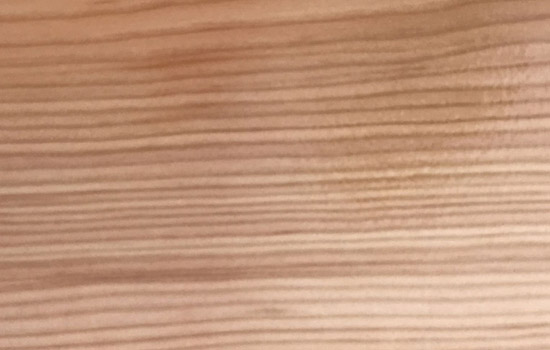Douglas FirReturn to S4S Lumber


Scientific Name: Pseudotsuga menziesii
Common Name: Douglas Fir
Janka Hardness: 620
Properties: Douglas Fir has a light brown color, that can tend red or yellow depending on location and age of the tree. The growth rings are darker and the thin ring of sapwood is light, almost white. Grain is usually straight, though it can have some wave, and the wood has a course texture to it. It is also one of the strongest of the softwoods, its tensile strength being remarkable for its weight. While being worked, Douglas fir has a sweet resin scent, though it fades with time.
Workability: Machines well, though is difficult to work with hand tools. May tear out unless cutters are sharp and has a blunting effect on blades. Glues well and holds clear finish or paint well, but staining may result in an uneven effect due to the large color variation between growth rings.
Uses: Douglas Fir is one of the most beloved species for Christmas Trees in the U.S., but as lumber, it is commonly used for construction, cabinetry, trim moulding, windows and doors, flooring, and furniture.
Fun Fact: Despite the name, Douglas Fir is not actually a fir species. It is not a pine, spruce, or hemlock, and instead has its own genus: Pseudotsuga, meaning “false hemlock.” The species name “menziesii” is from Scottish naturalist Arichibald Menzies, while the common name comes from David Douglas, another Scottish botanist who was the first to introduce the tree into cultivation.
S4S boards are surfaced on four sides and ready to use.
Clear Vertical Grain Douglas Fir, S4S (Ready to Use)
CVG Douglas Fir 1 X 4 - Actual Size 11/16" X 3-7/16”
CVG Douglas Fir 1 X 6 - Actual Size 11/16" X 5-5/16”
CVG Douglas Fir 1 X 8 - Actual Size 11/16" X 7-3/16”
Clear Mixed Grain Douglas Fir, S4S (Ready to Use)
CMG Douglas Fir 1 X 6 - Actual Size 11/16" X 5-1/8”
CMG Douglas Fir 1 X 8 - Actual Size 11/16" X 7-1/8”
Call for current pricing. Wholesale & commercial: 970.482.0222 Retail: 970.482.1928
* Species information excerpted from The Wood Database wood-database.com.
Common Name: Douglas Fir
Janka Hardness: 620
Properties: Douglas Fir has a light brown color, that can tend red or yellow depending on location and age of the tree. The growth rings are darker and the thin ring of sapwood is light, almost white. Grain is usually straight, though it can have some wave, and the wood has a course texture to it. It is also one of the strongest of the softwoods, its tensile strength being remarkable for its weight. While being worked, Douglas fir has a sweet resin scent, though it fades with time.
Workability: Machines well, though is difficult to work with hand tools. May tear out unless cutters are sharp and has a blunting effect on blades. Glues well and holds clear finish or paint well, but staining may result in an uneven effect due to the large color variation between growth rings.
Uses: Douglas Fir is one of the most beloved species for Christmas Trees in the U.S., but as lumber, it is commonly used for construction, cabinetry, trim moulding, windows and doors, flooring, and furniture.
Fun Fact: Despite the name, Douglas Fir is not actually a fir species. It is not a pine, spruce, or hemlock, and instead has its own genus: Pseudotsuga, meaning “false hemlock.” The species name “menziesii” is from Scottish naturalist Arichibald Menzies, while the common name comes from David Douglas, another Scottish botanist who was the first to introduce the tree into cultivation.
S4S boards are surfaced on four sides and ready to use.
Clear Vertical Grain Douglas Fir, S4S (Ready to Use)
CVG Douglas Fir 1 X 4 - Actual Size 11/16" X 3-7/16”
CVG Douglas Fir 1 X 6 - Actual Size 11/16" X 5-5/16”
CVG Douglas Fir 1 X 8 - Actual Size 11/16" X 7-3/16”
Clear Mixed Grain Douglas Fir, S4S (Ready to Use)
CMG Douglas Fir 1 X 6 - Actual Size 11/16" X 5-1/8”
CMG Douglas Fir 1 X 8 - Actual Size 11/16" X 7-1/8”
Call for current pricing. Wholesale & commercial: 970.482.0222 Retail: 970.482.1928
* Species information excerpted from The Wood Database wood-database.com.